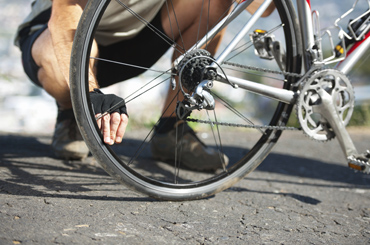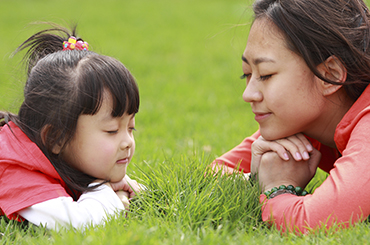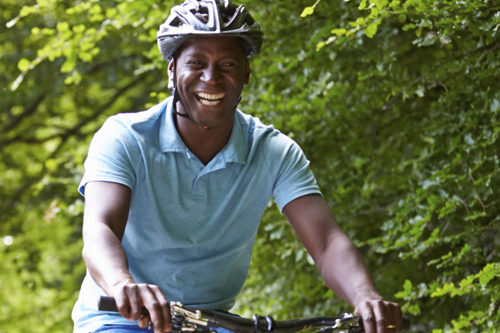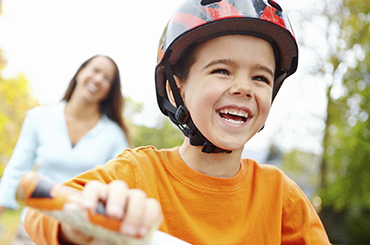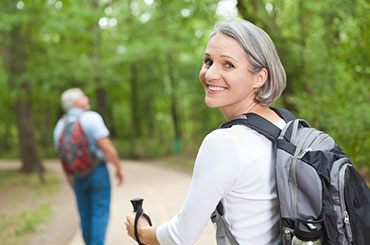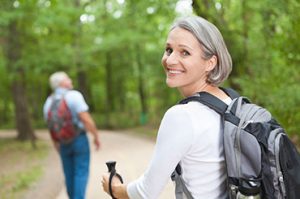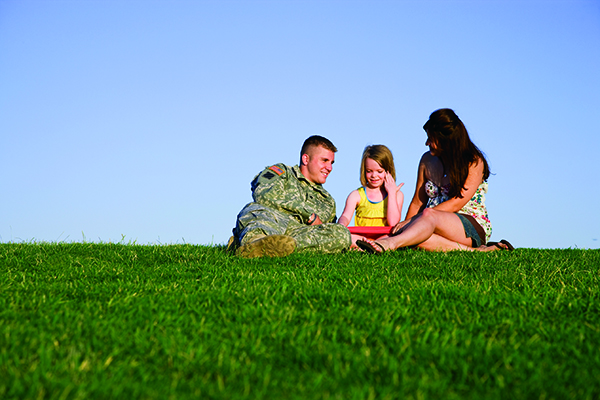Take Advantage of Autumn to Get Healthy

Fall is a time of shorter days, crisp air and leaves bursting with color. It can be melancholic, with winter approaching and summer over. But it also can be seen as an exciting time: the start of a new school year, a new sports season, a new television season and a countdown to the holidays!
Autumn is also time to focus on your health and visit your health provider for an annual checkup. Together, you’ll discuss overall health and preventive care and review your current symptoms. Your provider will update your family history and check on your cancer screenings and vaccinations. You’ll review your blood pressure, weight and heart rate and examine all the major body systems.
I liken these annual preventive exams to oil changes for your car: with regular preventive maintenance, we can spot trouble early and optimize longevity and quality of life.
Preventing illness
Flu season typically begins in the fall. The flu vaccine is the best way to prevent influenza, that malady of achiness, fever and a sore throat. Influenza and pneumonia combined are the eighth leading cause of death.
Those at high risk for complications or death from influenza are individuals with chronic diseases, the elderly, children, pregnant women and anyone with a compromised immune system.
The Centers for Disease Control and Prevention (CDC) recommends everyone age 6 months and older be vaccinated for the flu, but despite that, the overall U.S. vaccination rate hovers at around 50 percent.
As the weather chills and we head indoors, illnesses such as common cold viruses spread more readily. Being in close quarters increases the transmission of infectious organisms from person to person.
Good hand-washing is the key to preventing viruses and bacteria from spreading. It’s important to use soap and water and to scrub for at least 20 seconds before rinsing and drying your hands. You know you have scrubbed long enough if you can hum “Happy Birthday” while you wash your hands!
If you are on the go, alcohol-based hand sanitizers with at least 60-percent alcohol content are very effective but may not eliminate as many germs as soap and water.
Healthful foods
One of the most exciting things about autumn is the plethora of healthful foods that are in season. You might think of blueberries as a summer food, but many varieties remain available through the fall. Blueberries are chock full of antibiotics and vitamin C.
Apples are probably the most recognizable autumn fruit. Head to a local orchard and pick them yourself for best freshness and family fun! You get 4 grams of fiber per apple and 14 percent of your daily vitamin C. Apples are 85-percent water, so you also are hydrating yourself at the same time. And all of this for only 95 calories!
Brussels sprouts are ubiquitous in the fall. Just one-half cup provides more than your daily recommended intake of vitamin K. They’re enormously good sources of iron and folate — important for healthy blood cells.
Roasting Brussels sprouts with some olive oil and salt until they’re crisp on the outside but tender on the inside brings out great flavor and texture. Your kids will say they taste like French fries!
And how about all those autumn root vegetables and squash varieties? From sweet potatoes to parsnips, and pumpkins to butternut, the choices are endless. All of these contain high levels of vitamins A and C; phytonutrients, which have anti-cancer properties; and omega-3 fatty acids, which are heart-healthy.
Exercise
The long, hot days of summer that inspired your exercise routines might be gone, but don’t skimp on physical activity just because the days are cooler and shorter! Without the sweltering heat of summer, fall can actually be more conducive for outdoor exercise.
For most adults, the CDC recommends moderate intensity aerobic exercise for 30 minutes a day, five days a week. Intensity refers to the percentage of your maximum heart rate achieved. A good rule of thumb for moderate intensity is that you can carry on a light conversation while performing the exercise. Raking leaves, that common autumn chore, burns 315 calories per hour.
Finally, let’s not forget that National Family History Day is observed on Thanksgiving Day. It’s more than turkey and stuffing you’re sharing; it’s behaviors, lifestyles and genetics, too! Getting to know your family medical history and sharing it with your doctor is important to ensuring you are being screened appropriately for inherited conditions. French philosopher Albert Camus said, “Autumn is a second spring when every leaf is a flower.” Here’s to the fall season! Let’s enjoy this special time and take advantage of the opportunities autumn presents for optimizing our health.
AFM Outbreak in Seattle
Dr. Hamling participated in an interview on Fox Sports 1380am radio on Monday, November 14th to discuss the recent AFM outbreak in Seattle. Listen below:
Cycling Safety
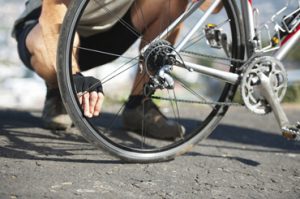
While many associate Seattle with coffee, rain or seafood, many Seattleites see the relationship between the city and cycling to be stronger.
With the start of summer behind us and a refreshing shift in typical summer weather patterns, the increase of cyclists on the road is evident. As more hit the road either for leisure, work or competitive purposes, it’s important to practice safe cycling methods to prevent injury.
The common injuries associated with cycling are usually due to overuse and improper bike fit. Common injuries can include knee pain, hand pain and numbness, neck or back strain and foot numbness or tingling. If pain starts to occur in one of these areas, resting, icing the area and checking the bike fit would be a good start. However, if the condition persists, consult your physician.
The right equipment
Having your bike properly fitted and fully maintained (e.g., gears shift smoothly, tires are inflated adequately and the chain is oiled versus rusted) is essential.
Poor posture on the bike can strain and cause pain in multiple areas, including the back, neck, shoulders and arms. A good bike fit helps with a cyclist’s ergonomics and can help minimize injuries related to poor posture/positioning. It can also help maximize your power while simultaneously minimizing fatigue.
If you’re uncertain how to ensure you’re doing everything correctly, ask for help at a local bike shop — they’re always willing to help out a fellow cyclist.
Always wear a helmet! Wearing a helmet can help prevent and minimize head injuries. A helmet should fit snugly and cover the top of your forehead. If it is tilting back like a bonnet, your brain is not protected and you need to try something else.
The straps should fit comfortably close to your face and chin, not dangling loosely as that will not help should an accident occur. A helmet is critical to your safety and health; spend time ensuring a good fit.
Train accordingly
During the summer, it is easy to turn a simple bike ride into an all-day adventure. It is encouraged to gradually build up to a race or long-distance stamina to avoid injury.
Start with a short ride and then add a few miles each time, building up to the full distance. This is especially important for those training for a ride like the Seattle to Portland Bicycle Classic. A sudden increase in training, high-intensity exercise or excessive knee bending can put excess pressure on the joints and lead to knee pain and tendonitis. Training beforehand makes certain you will enjoy the event more and feel better afterward.
Choose variety
Biking every day can overexert certain muscles. Varying your exercises can help strengthen other muscles that you don’t use while biking. Cross-training with exercises like yoga, weight lifting, running, etc., are great alternative methods. This will help prevent injury in the long run.
With any exercise comes risk of injury. But by using proper preventative care, the chances are less likely and the joy experienced is greater. Following these precautions will help make sure you and your bike are ready for a safe, fun summer. Now get out and enjoy the roads.
Controlling Allergies in Spring and Early Summer

Springtime brings sunshine, green grass, chirping birds, blooming bulbs and if you’re unfortunate enough to be a member of the sniffling, sneezing and itching community, then it’s time to carry your tissues. It’s the time of year when flowers, trees and ground molds release their pollen and spores into the air — better known as spring allergy season.
For some, the regional allergy season can begin as early as mid-January and last well into August. What causes this violent reaction in your body, how long will it last and what can you do to find relief?
It all starts with your immune system, which protects your body against microscopic organisms like bacteria and viruses. With seasonal allergies, your immune system overreacts to harmless pollens, dusts and molds.
These grains of pollen, dust or pet dander enter your nasal passages or mouth cavity and your immune system releases its histamine stores and other biochemicals, from mast cells, into your body.
These chemicals trigger a cascade response that results in helping to expel the offending agent by dilating blood vessels and increasing mucus production. This overreaction means you will suffer from sneezing attacks, coughing fits, watery or puffy eyes, itchy or flushed skin and even a sore throat, fatigue and headaches.
The timing for suffering from seasonal allergies is due to the cyclical nature of when trees, grasses and flowers in the Northwest begin to bloom and release their pollen. Typically, the peak tree-pollen season is from February to May, and grass and weeds allergy season is from April through July. Some years the season can span all the way through September.
In addition, our region offers a breadth of weather patterns that make predicting the start and stop of allergy season frustrating. Coupled with continual exposures of other allergens, such as pet dander and dust mites, seasonal allergies can last all year long.
Prevention is the best medicine and trying a few of these minor lifestyle changes can go a long way toward keeping your symptoms under control:
- Limit your early-morning outdoor time (5-10 a.m.) as this is when most plants and trees disperse their pollen.
- Avoid using fans that blow outdoor air into your home, as this can pull in pollen from outside.
- When driving, use your air conditioner to help to filter larger sized allergens.
- Use a dehumidifier to decrease mold growth in your home.
- Shower frequently to remove pollen from your skin and hair.
- Bathe your indoor pets regularly to remove pollen from their fur, and discourage them from sleeping in your bed or on other furniture.
- Use a face mask if you plan on doing extended gardening or mowing the yard.
For fast relief of mild symptoms, I recommend twice-a-day normal saline nasal rinses or using devices, such as a Neti pot, that will help to irrigate your nasal passages and rinse your sinuses. Over-the-counter antihistamines, such as Claritin and Benadryl, are great options and usually safe for most people and readily available at most drugstores.
Additionally, several types of antihistamine eye drops and mast cell stabilizers or corticosteroid nasal sprays are becoming more common over the counter. While eye drops can provide relief for itchy eyes, nasal sprays can help reduce swelling and irritation in your nose. These may help to augment other home treatments.
For those seeking more robust medical treatments and longer-term relief, there are two main forms of immunotherapy treatments, including intramuscular injections or sublingual drops. Both depend on a daily to weekly low-dose exposure to allergens to help remodel your immune system and thus decrease allergy symptoms.
These methods should be prescribed and followed closely by your doctor or allergist. Further research is focused on stopping the overall production of specific types of antibodies and the entire out-of-control cascading allergic response.
Spinning your wheels? Bike safety tips

Before you head out and hit the bike trails, take some steps to make sure you and your bike are ready for an excellent, safe summer season.
1. Stay Healthy with a Good Fit
Make sure your bike is properly fitted and maintained (e.g., gears change smoothly, tires are adequately inflated and chain is oiled and not rusted). A good bike fit can prevent neck and back aches, and shoulder and knee strains. It can also help you maximize power while minimizing fatigue. You can ask for help at a local bike shop. Or try these basic measurements:
- Stand over the bike on flat feet. You should have a minimum 1–2 inches of clearance above the frame.
- When sitting on your seat, your straight leg (with the pedal at the bottom of the stroke) should be bent about 20 to 30 degrees. And with your feet off the pedals, you should be able to touch the ground with just your toes.
- Handlebar height generally should be at or lower than the seat height and should be in a comfortable position for the rider. Ideally, you want to minimize strain on your hands, wrists and shoulders. And the height may vary with the type of bike—mountain or road—and the rider’s flexibility.
- The tilt of your seat should feel just right—not too far forward or backward. You should feel balanced and not like you’re sliding either way.
2. Protect the Old Noggin
Wear a helmet to prevent head injuries. Helmets should fit snugly and cover the top of your forehead. If they are tilted back like a bonnet, your brain is not protected! The straps should be comfortable and close to your face and chin, not dangling loosely. Take the time to play around with the straps to make your helmet fit right. If you can’t get it to fit properly, ask a friend or experienced bike shop to help. This is critical to your safety and health!
3. Work Up to It
Train before riding long distances to avoid injury. If you plan to do a race or long trip, start with a short ride and then add a few miles each time (but avoid increasing your mileage more than 10% per week). Build up to your full distance gradually (especially if you’re a novice rider). You’ll enjoy the event more and will feel better for the training!
4. Change It Up
Vary your exercises, instead of biking every day. Cross training with exercises like yoga, weight lifting and running can help strengthen other muscles that you don’t use while biking. This will help to prevent injury in the long run.
Now, hit the bike trails!
Outdoor Safety Tips for Your Children
 With the start of another beautiful Seattle spring and the promise of warmer weather to come, now is a great time to review outdoor safety tips with our children. It is always exciting for families to break out the bikes and skateboards as the days get longer and sunnier. But before you dust off the gear, be sure to brush up on family guidelines for playing safe and answer your kids’ questions.
With the start of another beautiful Seattle spring and the promise of warmer weather to come, now is a great time to review outdoor safety tips with our children. It is always exciting for families to break out the bikes and skateboards as the days get longer and sunnier. But before you dust off the gear, be sure to brush up on family guidelines for playing safe and answer your kids’ questions.
Getting the message across
It has been said that the best way to get your message across is to tailor it to your audience. When talking to kids, be keenly aware of the role their age and maturity plays in their ability to understand and follow the safety advice you give. Parents often underestimate what types of activities their kids will try and overestimate their ability to understand the consequences of the actions they take.
Add in the complication that younger children tend to attempt the awesome stunts that their older siblings and friends execute, and we soon understand that trouble could be lurking around any bend in the trail or over any homemade jump ramp in the neighbor’s driveway.
In general, the younger the child, the physically closer and more vigilant your supervision must be. This is especially true around bodies of open water and parks with beaches.
Also, younger kids often don’t understand the consequences of aggressive behaviors. This means that active play can sometimes spiral out of control and lead to someone getting hurt if a parent is not close by. To help your younger children be prepared for these situations, teach them the importance of asking adults for help when they feel things are getting out of control, feel uncomfortable or get separated from you.
Protective gear
As kids get older, sports and outdoor play are strongly encouraged — along with the appropriate protective gear. Individual and team sports typically have specific recommendations for protective equipment. However, parents who have novice athletes should ask both the coaches and other parents about essential types of safety equipment and their personal gear recommendations.
It is also a great way to see if anyone has second-hand gear to loan or sell so that the costs of outfitting a rapidly growing athlete do not get too exorbitant.
Appropriately fitting helmets, mouth guards and other head protection are especially important for sports such as football, baseball and lacrosse, as well as individual sports including biking, skateboarding and rollerblading. Also look into knee and elbow guards. The use of protective gear should be presented as a basic requirement and not a point of negotiation.
Of course, with the approach of longer days and more sunshine, it is also the perfect time to remind children about the need for sunscreen and sun-protective clothing. I recommend that kids use sunscreen with SPF 30 or higher; apply it at least 15 minutes before going outside and reapply it every two hours. Alternatively, a wide-brimmed hat and sun-protective clothing works well for children who don’t want to follow recommended sunscreen use or who may forget to reapply.
Going it alone
Do your kids like to bike? As the weather gets nice, many children start biking to school and friends’ houses. Reviewing traffic rules and safety tips for bicyclists is extremely important before your child takes off.
Lastly, this is the season when kids may walk to school by themselves or find themselves going to the park alone with greater frequency, so it is important to remind them to not talk to people they don’t know. Go over potential scenarios with your children. Even if they are with a friend, let them know that if they feel uncomfortable for any reason, it is OK to ask to come home.
Your child should be reassured that their safety is always your No. 1 concern and at the forefront of your thoughts throughout their childhood.
It’s February – Do you know where your resolutions are?

At the beginning of the year, many of us make New Year’s resolutions. We resolve to lose weight, quit smoking, exercise more and many other goals to improve ourselves. But a month into the New Year most people find that their motivation has started to wane.
As a psychotherapist, I regularly see people in my practice struggling to make and keep their goals. I work with my patients to set realistic goals and explore tools for keeping to them. If you find yourself in their predicament, here are a few ideas to consider:
Carefully select your goals. First, take a look at the past year. What were some of your successes? No matter how small, what was helpful in reaching those goals and what were your strengths? Think about how you would like your life to be different in six months, one year and five years. Make a short list of what you would like to change. If there are items on your list that have been difficult to change, make a few notes as to why those transformations are tough for you.
Be honest and compassionate with yourself. Do you really want the goals you have set and all that goes along with it? It takes time to achieve worthy goals. Ask yourself if you want the changes to be longstanding, since this means changing basic habits over the long run.
Make your goals achievable. Unrealistic goals will set you up for failure. Define smaller goals that are achievable. Instead of “work out every day,” try a smaller goal like exercising three times a week or walking for part of your lunch break at work. It is also important to pick an action, not a result. For instance, make it a goal to exercise three times a week, not lose 10 pounds.
Start small and build to success. Take time to recognize all progress you make toward your goal. I cannot stress enough that our minds and bodies need time to practice for longstanding habits. Writing down your goals and keeping them with you in your pocket, purse, laptop or smartphone can aid you in reaching your goals.
Planning is key to following through. For example, if your goal is a more healthful diet, prepare your shopping list well before you go to the store and avoid buying things that are not on your list. Prepare a week’s worth of food on the weekends and bring that food with you to work. Use trial and error here. When one strategy does not work, consider trying other strategies.
Support can make all the difference! Tell your family, partner or close friends about your resolutions, and ask them to check in with you. If possible, work with a friend who has a similar goal. Then when you are tempted to quit, he or she can encourage you to keep going. Make sure everybody who is important to you understands that you are going to do this.
Make a list of alternative ways to keep your resolution. This especially important when it comes to exercise and food. Our minds and bodies need flexibility in order to keep our goals. If you know you will be traveling or otherwise out of your normal routine, list different options so you can continue working toward your goal but also take into account you may not get in your normal workout or meal.
The goal that makes all the other goals achievable: Be good to yourself. Consider having this as your No. 1 goal for 2015. Everything else in life is easier if you are working on being good to yourself. “I can’t” or “all or nothing” thinking is very counterproductive. What are the healthy rewards that you enjoy? Where do you enjoy spending time? What gives you pleasure? There are going to be long days at work when you can only get in half of your workout, and there are going to be parties where you may not eat as healthily as you would like. The key is to recognize these moments and not let them sabotage you in reaching your end goal. Keep your eye on the big picture: you feeling healthy and happy!
Help your kids develop safe screen habits

Medical experts recommend that parents limit their children’s screen time to two hours per day and monitor where the devices are used.
Do you ever feel like your kids (and you) are spending too much time with electronic devices? Phones, iPods, computers, TV, video games, tablets — the choices seem endless and can draw users in for hours at a time.
Gone are the days of sitting and watching TV — electronics today invite us to actively communicate with friends and strangers alike and provide an open gateway to a limitless supply of ideas, images and stories. The Internet is like an all-you-can-eat buffet with an ever-changing menu.
Keeping up with your kids’ screen-time activities and providing parental guidance and oversight can be challenging. However, kids need help and guidance as they learn how to actively engage in the electronic world and make good choices. This learning will take place over time, and just like the rest of their life-learning, it is a journey. All children, including teens, should not be expected to navigate it on their own.
How do you teach and guide your child to maintain a healthy “media diet” from the Internet buffet? Here are some tips as you develop your own parental method for helping your kids develop healthy and safe screen habits.
- Make a family media plan that includes a written set of rules and guidelines that spell out your expectations for screen time and use of electronics for you and your kids — It should include specifics about time limits, device curfews, expectations for accessing age-appropriate content, guidelines for information not to be shared on the Internet and other safety issues, as well as consequences for not following house rules.
The American Academy of Pediatrics has a sample media plan entitled, “Media Time Family Pledge” at www.healthychildren.org.
- Set limits for screen time and location use — Keep all screens in public spaces and out of bedrooms, when possible. Limit your child’s ”entertainment screen time” to two hours a day or less. Turn off all media at mealtimes and at bedtime, preferably an hour or more before intended sleep.
At night, have your children put devices away or on a charger, out of reach from use. Set up an “overnight charging station,” where everyone’s mobile devices are checked in and docked for the night.
- Use the parental controls on devices to limit your kids’ access to only age-appropriate content — Setting up individual user profiles on shared devices and maintaining administrative privileges on the device’s settings can allow you to monitor use, block inappropriate sites, set time limits and monitor browsing history for individual users.
There is also downloadable parental monitoring software available to comprehensively monitor media activity across all devices.
Pay attention to video game and movie ratings, as well as online-account age restrictions when choosing media. Be transparent with your child about the kind of monitoring you will do.
- Consider your child’s age and development when making choices about the kinds of electronic devices you will allow them to use, as well as the content that is accessible with the use of the device — Restrict Internet access to your home Wi-Fi for preteens and younger children to more effectively monitor their early online activities.
Kids under 2 don’t need any screen time; unstructured play is best.
- Know the apps and social media sites your child is using — Research the site, see what others are saying and check if it has been in the headlines for safety concerns.
Registering your own profile on a social media site and “friending” your child allows you to monitor his/her activity, as well as understand the privacy settings and potential pitfalls.
Kids can fall prey to strangers’ online advances, cyberbullying and even posting of inappropriate and sometimes illegal material.
- Talk to your kids about what they are doing online — Engage by watching the shows and games they are playing; have them show you the apps and how they work. Ask them what they like and if they think there are any potential problems in using the media. Look for teachable moments from their insights, as well as your own personal experiences. News headlines about kids and their negative experiences on the Internet can be a good lead-in for conversations about “digital citizenship” and safety.
- Emphasize life balance — Set a good example for your kids by curbing your own screen use if it has infringed on family time or replaced other constructive activities.
Make sure your kids engage in some form of physical activity every day. Help them find non-screen based activities that both nurture their interests and allow them to share social time with others.
How women can keep their hearts healthy
Tips from Keiko Aikawa, MD, on how to avoid cardiovascular disease.
February is Heart Health Awareness Month, so it’s the perfect time to address the prevalence of cardiovascular disease in women and discuss ways to decrease risk for the development of the disease.
Cardiovascular disease is the leading cause of death in women in the United States. It kills more women than cancer, chronic lung disease, Alzheimer’s disease and accidents combined. Women typically develop cardiovascular disease 10 years later in life than men. After menopause, the incidence and severity of heart disease increase significantly. Women under the age of 45 who develop heart disease, however, have a worse prognosis compared to older women.
Between 1997 and 2012, women’s awareness of their own risks for heart disease has risen from 30 percent to 54 percent, due, in part, to a strong campaign by the American Heart Association to raise awareness and educate the public. But the level of awareness is still not where it should be. Trends of heart attacks are decreasing for men, but are increasing for women. Death rates for cardiovascular disease in women ages 35—55 years old are increasing and can partially be explained by the obesity epidemic.
When I see patients, I always ask about risk factors that may put them at increased risk for heart disease such as obesity and a sedentary lifestyle. Diabetes and smoking are greater risk factors for heart disease in women than in men. Menopause, including surgical menopause, increases a woman’s risk of heart disease because estrogen is protective against cardiovascular disease. I also look for evidence of abnormal lipids including high LDL cholesterol, low HDL cholesterol and elevated triglycerides. Autoimmune diseases such as lupus or rheumatoid arthritis are less well-known risk factors.
Additionally, pre-eclampsia, pregnancy-induced hypertension and gestational diabetes are early indicators of a woman’s future cardiovascular risk.
Next, I ask patients about their family history. Having a first-degree relative with premature coronary artery disease — defined as younger than 55 years old in men and younger than 65 years old in women — increases one’s risk.
Once you know your risk factors, you can take steps toward prevention. Here are some of my recommendations for living a heart-healthy life:
- Avoid smoking. Smoking as few as one to four cigarettes a day can double your risk for cardiovascular disease.
- Maintain a healthy weight and exercise. It’s important to keep a healthy weight and aim to have a body mass index of less than 25 kilograms/meters squared and a waist circumference of less than 35 inches. To support these goals, engage in moderate exercise for at least 30 minutes, five days per week with sustained aerobic activity for at least 10 minutes at a time. (Additional benefits occur when one participates in moderate exercise for five hours per week.)
- Eat a heart-healthy diet. This includes limiting sodium intake to less than 1,500 mg per day and sugar intake to five tablespoons or less per week, limiting foods high in saturated fats and cholesterol, and avoiding trans fats.
- Treat other illnesses and diseases that put you at risk. Ensure that you are treating any diagnoses of hypertension, hyperlipidemia and diabetes mellitus with lifestyle modification or medications.
- Test for high cholesterol. I would recommend that women older than 20 have their lipids checked at least once to see if you’re at risk.
The advice I give to those who want to improve or maintain heart health is this: living a heart-healthy life often requires a lifestyle change. There is not a “diet” that one must get through or an exercise program one must try. It requires a mental shift in how you view exercise and diet and how you prioritize your heart health in your life.
I see many patients who work long, hard hours and have busy family lives and find themselves too busy or too tired to exercise, and too busy or tired to cook a healthy meal or go grocery shopping. It’s a very difficult situation where they cannot make their health a priority due to external pressures. I stress to my patients that when they make time for themselves and their health, they will see huge benefits in the long run so that they can continue to live happy and healthy lives into the future.
Dr. Aikawa is a cardiologist at PacMed.
Compensation Commission Cites USFHP as Important Example of Population Health Management
Arlington, VA – The Final Report of the Military Compensation and Retirement Modernization Commission calls the U.S. Family Health Plan (“USFHP”) “An important example” of how to use “nonprice tools to manage patient care.” The commission recommends the US Family Health Plan continue to be among the health care choices available to military families in a new OPM-administered program.
“The Commission has reaffirmed USFHP as a provider of high quality care that improves health and keeps people out of the hospital,” said Jim Schweiter, Chief Executive Officer for US Family Health Plan Alliance. “The Commission’s recognition of USFHP as an example of care management practices that the rest of TRICARE should emulate is very gratifying.”
Population health management is the direction of future medical care in the United States. We are pleased that the Commission recognized this trend as it considered the future of the TRICARE health benefit,” said David Howes, president of Martin’s Point Health Care, a US Family Health Plan member and chair of the Alliance’s board of directors. “The Commission also recognized the value of the US Family Health Plan in using tools to avoid inpatient admissions, prevent readmissions and shorten hospital stays. The US Family Health Plan is renowned for providing high quality health care to beneficiaries. As everyone familiar with this plan knows, patient satisfaction among its members has long been among the highest in the Department of Defense health care system.”
In its report, the Commission recognized the USFHP program for its use of “population health” managed care techniques which include “disease management, wellness, and better coordination of care.” The commission report notes that compared to TRICARE Prime, USFHP participants, have 33 percent fewer inpatient days and 28 percent fewer emergency room visits than other TRICARE Prime enrollees.
The commission commended USFHP for “identifying high-risk patients, managing complex cases, keeping chronic diseases under control, and promoting wellness and preventative services.” As a result of the success of the USFHP program’s managed care techniques, the Commission recommended that the program continue in the new system of care proposed in its report.
About the US Family Health Plan
The US Family Health Plan is among the health care choices for eligible beneficiaries of the Department of Defense’s TRICARE Prime program. Health care is provided to active-duty family members, including activated National Guard and Reserve family members, and retirees and their family members. Care is provided through large, local civilian health care networks of primary care physicians, hospitals and affiliated specialists. Patients choose a primary physician who provides and coordinates care and referrals to specialists and hospitals. The US Family Health Plan Alliance is the association that represents the collective interests of the regional USFHP networks in interactions with Congress, the Department of Defense, and the private sector.
To learn about the USFHP in the Northwest follow this link.





